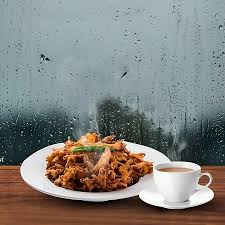My Monsoon

My Monsoon
As soon as the monsoon clouds roll in, every one of us, especially me, begins to dream of hot chai and crispy pakoras. But beyond that, there are several important things we need to keep in mind for a healthy monsoon journey. I’ll come to those in a bit, but first, let’s finish the pakora talk! (It’s my favourite too, haha.)
During the monsoon, many of us experience strong cravings for fried foods. But have you ever wondered why that happens?
There’s a very interesting reason behind it.
During the monsoon, the environment becomes damp and humid due to constant rains and moisture in the air. This external humidity affects our body too — making us feel heavy, sluggish, and moist from within. According to Ayurveda, this is the time when our Jatharagni (digestive fire) becomes weak or “shaant,” which means our digestion slows down.
This is where fried foods come into the picture.
When we eat something hot and oily, like pakoras, it brings warmth and dryness to our system — helping balance the internal humidity. That’s why we often feel lighter and better after having them. However, I always make sure to prepare pakoras with a few important things in mind.
My Monsoon Pakora Rules:
- Use Mustard Oil, Never Refined: Mustard oil not only adds a sharp, warming flavour but also has natural antimicrobial and digestion-supporting properties.
- Add Immunity-Boosting Spices: I always include ingredients like ginger, turmeric, and black pepper. These spices help boost immunity and stimulate digestion, both very important in the monsoon season.
- Eat Occasionally, Not Daily: While it’s lovely to enjoy pakoras during a rainy day, I don’t recommend having them too often. Overeating fried foods can lead to weight gain and make digestion even slower.
So yes, enjoy those golden fritters when the rain taps on your window, but keep them occasional, spice them wisely, and fry them the traditional way!
Now Let’s Talk About Monsoon Food Habits
During the monsoons, I avoid uncooked foods, especially raw salads, salad leaves, and leafy vegetables. The reason is that our digestion weakens during this season due to low Jatharagni (digestive fire). Raw vegetables and leafy greens are harder to digest in this state, and they can easily lead to bloating or indigestion.
Also, during the rainy season, there’s a higher risk of pests and bacterial growth on leaves. That’s why farmers often spray a lot of chemicals on them. So even though leafy greens are generally healthy, it’s better to avoid them during monsoon. I’m speaking from personal experience, I’ve faced the consequences myself.
Because of the high humidity in the air, bacteria multiply faster. So, never leave cut fruits outside or even in the refrigerator. Always eat fruits immediately after cutting them. Yes, I know it sounds like a lot to remember — but trust me, it’s easier than dealing with fevers, viral infections, or stomach issues caused by small mistakes.
One more thing I strongly follow is eating only freshly cooked food during these two months. Try not to store and reuse cooked food from the refrigerator. The monsoon always reminds me of my hotel and restaurant days, where we followed strict practices like these to maintain food safety and health.
Also, it’s wise to reduce dairy consumption during this season, and I recommend completely avoiding non-vegetarian food, especially seafood, which spoils quickly in humid weather.
If you’re eating lentils, go for moong dal or arhar dal. Avoid heavier or gas-forming dals like black dal, rajma, or chickpeas, which are harder to digest in this season.
Now make your monsoons as joyful as the tip-tip rain by keeping these simple things in mind! You can even turn them into easy tips and share them with others, just like I do.
Let’s help at least three people by sharing this with them, and ask each of them to pass it on to three more. Haha, yes, I know it’s a famous dialogue from a movie, but it’s actually quite effective if we all follow it!

.png)















